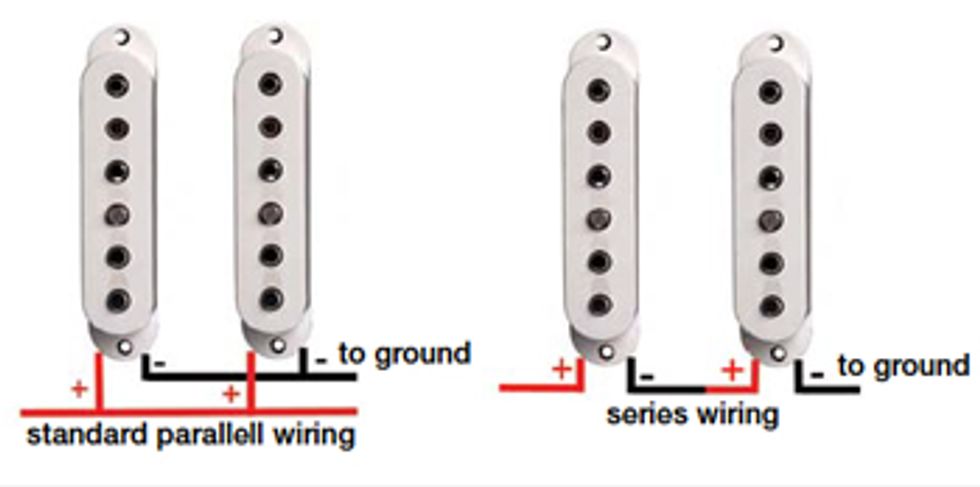
LEFT: On a stock, modern Strat, the dual-pickup settings (positions 2 and 4) use a parallel wiring scheme. RIGHT: When two pickups are wired in series, the output of one pickup goes into the input of the other, increasing volume and emphasizing low and midrange tones.
Hey fellow guitarists, it's time for another cool mod. In this and next month's column, we'll explore parallel/series pickup switching schemes for the single-coil pickups in your Strat. We'll begin with some theory and then look at several cool applications for this wiring.
As you know, like most guitars sporting more than a single pickup, your Strat lets you select any pickup by itself or choose certain dual-pickup combinations. The standard way to connect multiple pickups is to wire them in parallel. This generates the classic tone our ears know from countless records, when a guitarist uses the bridge and middle or middle and neck pickups in tandem (positions 2 and 4 on a normal 5-way Strat switch).
Only a few guitars use series wiring for their pickups. The most popular examples of series setups are the Brian May “Red Special" and almost all Danelectro guitars.
There are several good reasons why you might want to wire your Strat pickups in series. If you want more volume and midrange out of your pickups, the parallel/series switching may be the perfect option. As I mentioned, parallel wiring of two pickups is what you are used to hearing from a Strat. Parallel wiring adds transparency and clarity to the tone.
In contrast, wiring two pickups in series produces a longer path with increased resistance, adding volume while preventing the highest frequencies from getting through. With series wiring, the output of one pickup goes into the input of another pickup, while with standard parallel wiring, each pickup takes its own path to the output. Besides being noticeably louder, series wiring emphasizes low and midrange tones, and this is a perfect combination to drive any tube amp into saturation without the help of a booster.
It's interesting to note that series wiring is a fairly standard Telecaster mod, but not one you commonly find on Strats. Let's change that! It's also worth mentioning that neither series nor parallel wiring has any effect on the sound when only one pickup is selected. The differences occur only when two pickups are combined.
To understand the difference between parallel and series wiring of two pickups, check out the two diagrams. In the first, the two pickups are wired in parallel, so both pickups' inputs and outputs are connected together. This is one of the main reasons why a Strat usually has a very bright tone—parallel wiring allows the signal from each pickup to reach the output jack by the shortest possible route. The result is that the high frequencies reach the output jack almost unchecked, giving your Strat that sparkling sound we all love so much.
In the second diagram, the two pickups are wired in series. The theory behind series wiring is that the ground wire of one pickup is connected to the hot wire of the other pickup. As a result, they become a kind of compound pickup, with one ground and one hot for both. When wired in series, the pickups combine their impedance (resistance) and the output is very high. If your Strat's middle pickup is a reverse-wound/ reverse-polarity type (aka RWRP), you'll get the same humbucking effect as you do when the pickups are wired in parallel—no changes there.
When two pickups are wired in series, a good portion of the treble frequencies is lost because the long pickup wire works like a resistor. Any resistor in the signal path will suppress the signal. The formula works like this: The longer the wire, the higher the resistance, and the more treble is lost. We all know this from guitar cables: When you use a very long guitar cable, the sound isn't as detailed and transparent as it is with a shorter cable. A long cable acts as a resistor.
Higher frequencies are more attenuated by a resistor than lower frequencies, and this explains why pickups wired in series offer more prominent low and midrange timbres. The signal has to travel through twice as much pickup wire to reach the output jack compared to parallel wiring—and that's a lot of wire!
We now know why series wiring attenuates the highs, but why is it louder? Why do you end up with such a beefy, meaty tone? Let's assume each pickup on your Strat puts out 100 x of power. When wiring two pickups in parallel, each pickup loses 3/4 of its output when combined with the other. This drops each pickup's output to 25 x, instead of 100 x. Together, you get a total of 50 x (25 x + 25 x). This power drop is why any dual-pickup combination on your Strat doesn't sound as loud as a single pickup.
But with the same two pickups wired in series, you'll receive 100 x + 100 x, resulting in a total of 200 x. Because the two pickups are wired one into another, the output from the first pickup is added to the output of the second one. This generates a much louder tone.
However, 50 x does not mean that the two pickups wired in parallel are only half as loud as a single pickup, nor does 200 x mean that the two pickups wired in series are twice as loud as one pickup. Our human hearing does not work this way. Why that's the case is beyond the scope of this column, but for our guitar-wiring purposes, it's enough to know that the human ear doesn't operate in a linear way.
Stay tuned for the second part of our series/parallel discussion next month. We'll pick up the soldering iron and explore some sweet parallel/ series switching options for our Strats. This will also close out our run of Stratocaster mod columns. When we finish the series/parallel discussion, we'll switch over to Telecaster and Esquire mods. Until next time, keep on modding!
Dirk Wacker lives in
Germany and is fascinated
by anything related to old
Fender guitars and amps.
He plays country, rockabilly,
and surf music in two
bands, works regularly as a
session musician for a local studio, and writes
for several guitar mags. He's also a hardcore
guitar and amp DIY-er who runs an extensive
website—singlecoil.com—on the subject.








![Rig Rundown: Russian Circles’ Mike Sullivan [2025]](https://www.premierguitar.com/media-library/youtube.jpg?id=62303631&width=1245&height=700&quality=70&coordinates=0%2C0%2C0%2C0)


























